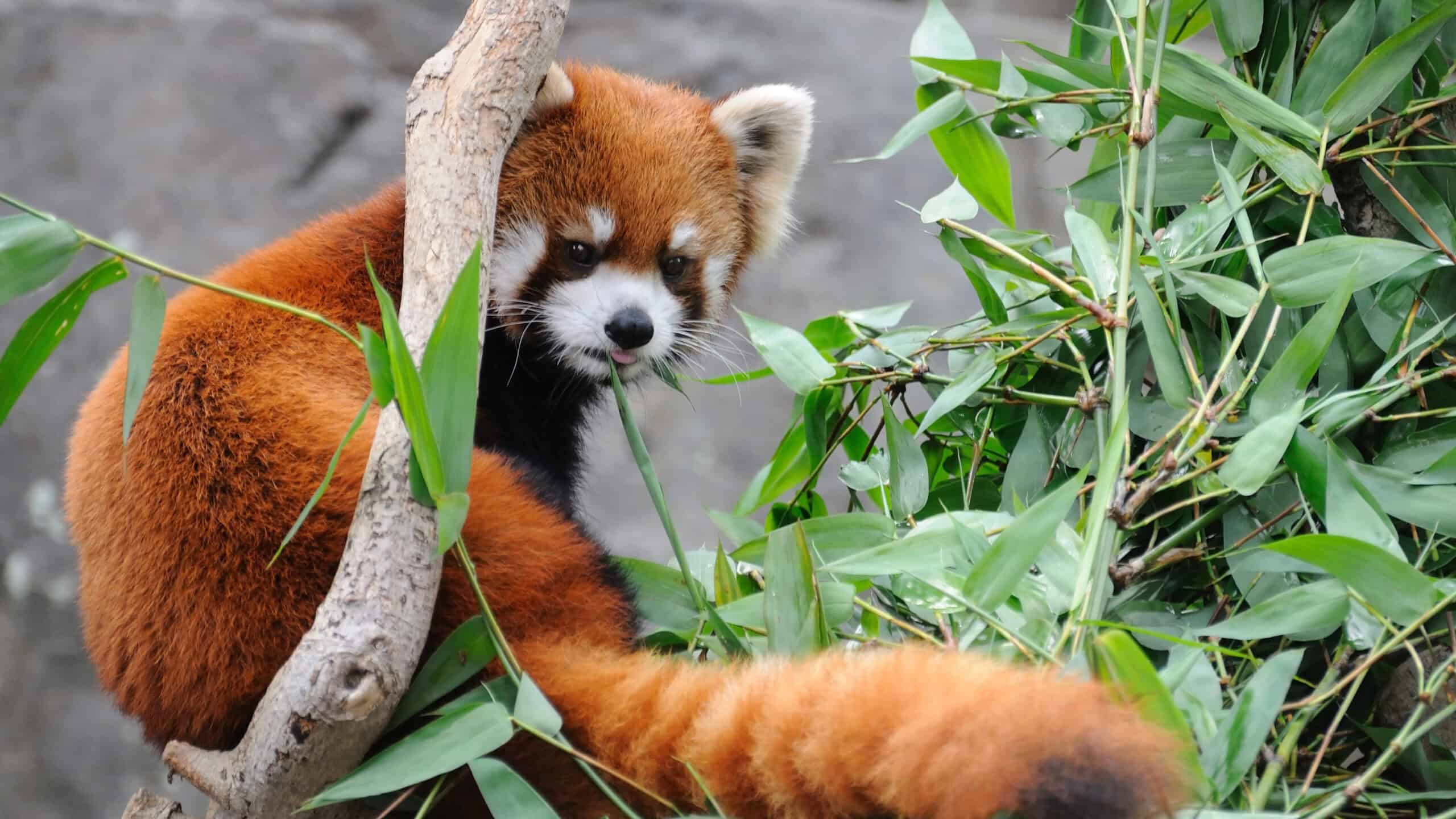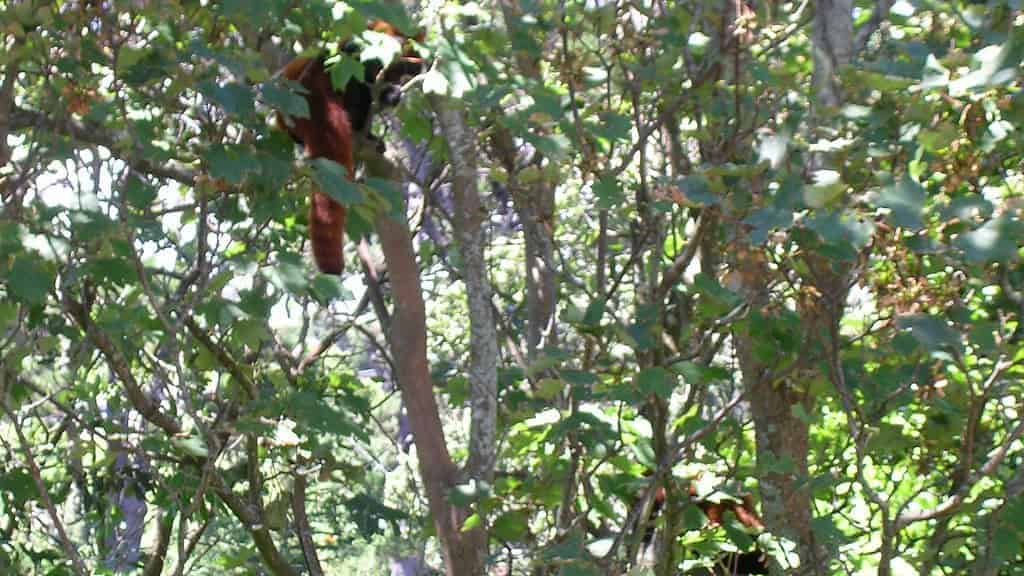The red panda, with its distinctive rusty-red fur and adorable appearance, might seem like an animal that would stand out in its natural habitat. However, these remarkable creatures have evolved sophisticated camouflage techniques that help them blend seamlessly into their mountain forest environments. Despite being named “pandas,” red pandas (Ailurus fulgens) are actually more closely related to raccoons and weasels than to their namesake giant pandas. In the misty forests of the eastern Himalayas and southwestern China, these endangered mammals utilize various camouflage strategies to evade predators and survive in an increasingly threatened habitat. This article explores the fascinating ways red pandas employ camouflage as a crucial survival mechanism in their daily lives.
The Perfect Color Match for Forest Environments

The most obvious aspect of the red panda’s camouflage is its rusty-red fur covering most of its body. This coloration is not merely decorative but serves a vital survival function. The reddish-brown hue perfectly matches the color of the moss and lichens that grow abundantly on the trees in their native habitat. When a red panda rests on moss-covered branches, its body blends remarkably well with this background, making it difficult for predators like snow leopards and martens to spot them from below or from a distance. Additionally, in autumn, when the forests transform into shades of orange and red, the pandas become even more difficult to distinguish among the falling leaves and changing foliage.
The Strategic Black and White Facial Markings

Red pandas have distinctive white and black facial markings that might initially seem to make them more visible. However, these markings serve important camouflage functions. The white patches on their face, particularly around the muzzle, ears, and above the eyes, help break up the outline of their face when viewed against dappled light in the forest canopy. The dark “tear marks” running from their eyes to the corners of their mouth serve a similar function to those found in cheetahs – they help reduce glare from sunlight, enhancing visual acuity while hunting or foraging. These contrasting patterns create a form of disruptive coloration that makes it harder for predators to recognize the red panda’s facial outline and distinguish it from the complex patterns of light and shadow in their forest habitat.
Utilizing Tree Canopies as Natural Cover

Red pandas spend much of their lives in trees, and this arboreal lifestyle forms a crucial component of their camouflage strategy. These animals are remarkably agile climbers, capable of navigating the highest branches of fir trees and other conifers native to their mountainous habitats. By staying within the dense tree canopies at elevations of 2,200 to 4,800 meters, red pandas can remain hidden among the thick foliage. Their relatively small size (typically weighing between 3 to 6 kg) allows them to balance on even the thinnest branches and hide within leaf clusters. Scientists have observed that red pandas often choose resting spots in the middle layers of the canopy, where the combination of height and foliage density provides optimal concealment from ground predators while still offering escape routes if danger approaches from above.
The Camouflaging Role of Their Ringed Tails

The red panda’s bushy tail, marked with approximately 12 alternating red and buff rings, serves multiple functions beyond balance. This ringed pattern creates a disruptive effect that helps break up the animal’s outline when viewed against the dappled light filtering through the forest canopy. When a red panda wraps its tail around itself while sleeping on a branch – a common resting posture – the rings blend with the patterns of light and shadow cast by leaves and branches. The tail, which can be nearly as long as the body itself (30-50 cm), also provides excellent camouflage when wrapped around the face during sleep. This posture not only provides warmth in the chilly mountain air but also conceals the more visible parts of the red panda’s face, further enhancing its camouflage when at its most vulnerable.
Seasonal Adaptations in Fur Density and Color

Red pandas exhibit remarkable seasonal adaptations in their fur that enhance their camouflage capabilities throughout the year. During winter months, their fur grows thicker and slightly darker, helping them blend with the darker, dormant vegetation and providing crucial insulation in temperatures that can drop below freezing. In summer, they shed their dense undercoat, and their fur often appears slightly lighter, which better matches the brighter forest environment of the growing season. This seasonal variation in fur density and subtle color shifts ensures that red pandas maintain effective camouflage year-round, despite the dramatic seasonal changes in their mountain forest habitats. Research has shown that these seasonal changes are triggered by hormonal responses to changing day length, demonstrating how deeply integrated camouflage adaptations are in the red panda’s biology.
Nocturnal Activity Patterns as a Form of Temporal Camouflage

Beyond physical camouflage, red pandas employ what biologists call “temporal camouflage” – being active when predators are least likely to detect them. Red pandas are primarily crepuscular and nocturnal, meaning they are most active at dawn, dusk, and throughout the night. During these low-light periods, their rusty coloration appears darker and less distinct, making them harder to spot even for predators with good night vision. By sleeping during daylight hours, typically curled up in tree hollows, dense foliage, or rock crevices, they minimize exposure during times when their coloration might be more visible. Studies using motion-activated cameras have revealed that red pandas are approximately 75% more active during nighttime hours, clearly demonstrating how their activity patterns complement their physical camouflage strategies to maximize survival.
Behavioral Tactics That Enhance Camouflage Effectiveness

Red pandas have developed specific behaviors that enhance the effectiveness of their physical camouflage. When threatened, they often freeze in place rather than fleeing immediately, relying on their camouflage to avoid detection. This stillness prevents movement that might catch a predator’s eye. If spotted, they may attempt to hide by pressing their bodies flat against tree branches or retreating to tree hollows. As a last resort, red pandas can stand on their hind legs to appear larger and more threatening, but this is typically only after their camouflage strategy has failed. They also tend to move slowly and deliberately when foraging, which minimizes the chance of drawing attention through sudden movements. These behavioral adaptations work in concert with their physical camouflage to create a comprehensive survival strategy that has helped the species persist despite numerous environmental challenges.
The Role of Habitat in Camouflage Effectiveness

Red panda. Image via Unsplash
The specific habitats red pandas occupy are crucial to the effectiveness of their camouflage. They prefer temperate forests with dense bamboo understories, typically at elevations between 2,200 and 4,800 meters. These environments are characterized by frequent mist and cloud cover, creating diffuse lighting conditions that further obscure the outlines of red pandas as they move through the trees. The presence of moss, lichens, and reddish-brown vegetation provides background matching opportunities that would be absent in other environments. Research has shown that red pandas select resting sites with specific characteristics that maximize camouflage: branches with diameters of 10-15 cm that provide stability, moderate heights of 10-30 meters that balance safety with accessibility, and locations with 60-80% canopy cover. This selective habitat use demonstrates how intricately the red panda’s camouflage strategy is linked to specific environmental features of their mountain forest homes.
Camouflage Differences Between Cubs and Adults

Red panda cubs demonstrate interesting differences in camouflage compared to adults. Newborn cubs have dense gray-brown fur rather than the distinctive rusty-red coloration of adults. This more neutral coloration helps them blend into the nest environment, typically located in hollow trees or rock crevices lined with moss, leaves, and small branches. As they develop and begin to explore outside the nest at around 3 months of age, their fur gradually transitions to the adult coloration. During this vulnerable period when they are learning climbing skills but lack the agility of adults, their slightly duller coat provides better camouflage on the forest floor and lower branches where they spend more time. The transition to adult coloration coincides with improved climbing abilities and greater use of the canopy habitat, demonstrating how camouflage adaptations align with behavioral development throughout the red panda’s life cycle.
How Camouflage Helps Red Pandas Avoid Multiple Predator Species

Red pandas face threats from several predator species, and their camouflage has evolved to be effective against multiple hunting strategies. Snow leopards, their primary predator, hunt primarily using sight and rely on ambush tactics – the red panda’s ability to blend with tree branches helps counter this threat. Martens, which can follow red pandas into the trees, have excellent smell but less acute color vision, making the visual camouflage of red pandas particularly effective against them. Wild dogs and jackals occasionally prey on red pandas that venture to the ground; in these instances, the dappled lighting of the forest floor combined with the red panda’s coloration provides crucial protection. Even large birds of prey like eagles present a threat from above, but the red panda’s reddish back blends with tree branches when viewed from this angle. This multi-predator protection demonstrates the sophisticated nature of red panda camouflage, which must be effective against threats coming from different directions and employing different hunting techniques.
Challenges to Camouflage in Changing Habitats

As human activities increasingly fragment and alter red panda habitats, these animals face new challenges to their camouflage effectiveness. Deforestation reduces canopy cover and removes the complex visual backgrounds against which red pandas blend. Climate change is shifting the composition of mountain forests, potentially creating mismatches between the red panda’s evolved coloration and their changing environment. For instance, as warmer temperatures cause tree lines to move upward, red pandas may be forced into areas with different vegetation patterns that make their camouflage less effective. Edge effects at forest boundaries create different light conditions that can make red pandas more visible. Additionally, the reduction in bamboo understory due to livestock grazing eliminates crucial hiding places for red pandas when they descend to the forest floor. Conservation efforts now include consideration of these habitat characteristics that support effective camouflage, recognizing that protecting the red panda requires preserving not just any forest, but the specific forest structure in which their camouflage functions optimally.
The Evolutionary Development of Red Panda Camouflage

The sophisticated camouflage of red pandas represents millions of years of evolutionary refinement. Fossil evidence suggests that ancestors of modern red pandas existed as far back as 25 million years ago, with the modern species evolving its distinctive features over approximately 5 million years. During this time, natural selection has favored individuals whose coloration and behavior made them less visible to predators in their specific habitat. Genetic studies have identified several genes associated with coat color in red pandas, including MC1R and ASIP, which regulate the production of red and yellow pigments. Interestingly, these genetic adaptations for camouflage have evolved independently from those of the giant panda, despite both species adapting to similar bamboo forest habitats – a remarkable example of convergent evolution. The persistence of red panda camouflage traits across their range, despite some regional variations in size and coloration, demonstrates the critical survival advantage these features provide and how deeply embedded they are in the species’ evolutionary history.
The red panda’s sophisticated camouflage system represents one of nature’s most remarkable examples of adaptive evolution, combining physical characteristics, behavioral strategies, and habitat selection to create a comprehensive survival mechanism. As this endangered species faces mounting threats from habitat loss, climate change, and poaching, understanding how their camouflage functions in natural environments becomes increasingly important for effective conservation strategies. The fact that red pandas have relied on these camouflage adaptations for millions of years highlights the delicate balance between these animals and their specific forest habitats – a relationship that cannot be easily replicated or restored once disrupted. By appreciating the complexity and effectiveness of red panda camouflage, we gain not only scientific insight into evolutionary processes but also a more profound understanding of what must be preserved to ensure these remarkable creatures continue to find safety in their increasingly threatened mountain forest homes.
- America’s Most Endangered Mammals And How to Help - August 9, 2025
- The Coldest Town in America—And How People Survive There - August 9, 2025
- How Some Birds “Steal” Parenting Duties From Others - August 9, 2025

